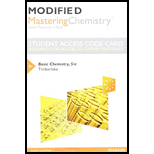
(a)
Interpretation:
Interpret the heat change in joules to condense 10.0 g of steam.
Concept Introduction:
Heat for changing the state of water from ice can be determined as:
Heat required for changing the state of ice from solid to liquid.
Where, m is mass of ice or water
S is specific heat of water
dT is the change in temperature
(b)
Interpretation:
Interpret the heat change in kJ to condense 76.0 g of acetic acid.
Concept Introduction:
Heat for changing the state of water from ice can be determined as:
Heat required for changing the state of ice from solid to liquid.
Where, m is mass of ice or water
S is specific heat of water
dT is the change in temperature
(c)
Interpretation:
Interpret the heat change in joules to vaporise 44 g of ammonia.
Concept Introduction:
Heat for changing the state of water from ice can be determined as:
Heat required for changing the state of ice from solid to liquid.
Where, m is mass of ice or water
S is specific heat of water
dT is the change in temperature
(d)
Interpretation:
Interpret the heat change in kJ to vaporise 5 kg of water.
Concept Introduction:
Heat for changing the state of water from ice can be determined as:
Heat required for changing the state of ice from solid to liquid.
Where, m is mass of ice or water
S is specific heat of water
dT is the change in temperature
Want to see the full answer?
Check out a sample textbook solution
Chapter 10 Solutions
Modified Masteringchemistry With Pearson Etext -- Standalone Access Card -- For Basic Chemistry Format: Access Card Package
 ChemistryChemistryISBN:9781305957404Author:Steven S. Zumdahl, Susan A. Zumdahl, Donald J. DeCostePublisher:Cengage Learning
ChemistryChemistryISBN:9781305957404Author:Steven S. Zumdahl, Susan A. Zumdahl, Donald J. DeCostePublisher:Cengage Learning ChemistryChemistryISBN:9781259911156Author:Raymond Chang Dr., Jason Overby ProfessorPublisher:McGraw-Hill Education
ChemistryChemistryISBN:9781259911156Author:Raymond Chang Dr., Jason Overby ProfessorPublisher:McGraw-Hill Education Principles of Instrumental AnalysisChemistryISBN:9781305577213Author:Douglas A. Skoog, F. James Holler, Stanley R. CrouchPublisher:Cengage Learning
Principles of Instrumental AnalysisChemistryISBN:9781305577213Author:Douglas A. Skoog, F. James Holler, Stanley R. CrouchPublisher:Cengage Learning Organic ChemistryChemistryISBN:9780078021558Author:Janice Gorzynski Smith Dr.Publisher:McGraw-Hill Education
Organic ChemistryChemistryISBN:9780078021558Author:Janice Gorzynski Smith Dr.Publisher:McGraw-Hill Education Chemistry: Principles and ReactionsChemistryISBN:9781305079373Author:William L. Masterton, Cecile N. HurleyPublisher:Cengage Learning
Chemistry: Principles and ReactionsChemistryISBN:9781305079373Author:William L. Masterton, Cecile N. HurleyPublisher:Cengage Learning Elementary Principles of Chemical Processes, Bind...ChemistryISBN:9781118431221Author:Richard M. Felder, Ronald W. Rousseau, Lisa G. BullardPublisher:WILEY
Elementary Principles of Chemical Processes, Bind...ChemistryISBN:9781118431221Author:Richard M. Felder, Ronald W. Rousseau, Lisa G. BullardPublisher:WILEY





